Investigation and prosecution of sexual crime: follow-up review
Follow up to HM Inspectorate of Prosecution in Scotland's 2017 review of the investigation and prosecution of sexual crimes
Appendix 1: Case review
165. To support our assessment of the extent to which the recommendations made in our 2017 review have been implemented, we examined 50 High Court sexual crime cases. The sample of cases was randomly selected from all sexual crime reported to COPFS between 1 September 2018 and 28 February 2019 and which were assessed as being suitable for action in the High Court.[43] While our sample size was not statistically significant, the results from the 50 cases should nevertheless provide a good indication of how sexual crime cases are being managed and progressed. Our sample represents 13% of all High Court sexual crime reported to COPFS during the six-month period. The management and progression of the cases was assessed until 20 March 2020. We revisited the live cases in July 2020 to assess the impact of the Covid-19 pandemic.
Overview
166. Of the 50 cases, 22 (44%) were still ongoing at 20 March 2020. Twenty-eight (56%) cases were closed.
167. In each of the 50 cases, we noted the main charge at the time the case was reported by the police. We deemed the main charge to be the one that would result in the most severe penalty. Rape was the main charge in 42 (84%) cases. This included offences under sections 1 (rape) and 18 (rape of a young child under the age of 13) of the Sexual Offences (Scotland) Act 2009 and, in relation to crimes committed prior to 1 December 2010[44], the common law crimes of rape and sodomy (see Charts 1 and 2). As the investigation continues and further evidence is gathered, the main charge in a case may change and some charges may be removed and others added. For example, one case was reported with the main charge being assault to injury however it was anticipated that following further investigation, a charge of rape may be added.
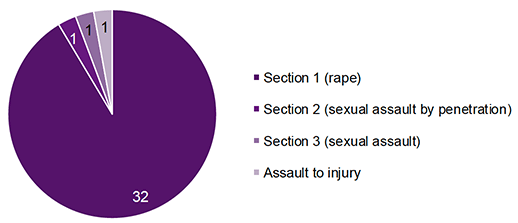
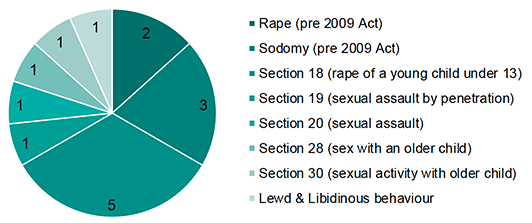
168. Each case involved one accused person, and all the accused were male. Their ages ranged from 13 to 79, with five being under the age of 18 at the time the cases were reported to COPFS.
169. Half of the cases had multiple victims. There were 113 victims across the 50 cases, of whom 28 were children aged between five and 17 at the time the case was reported. Many more victims were children at the time of the crime.
170. Only four (8%) cases related to crimes that had taken place within the year preceding the police report, and a further 33 (66%) related to crimes that had taken place in the previous five years. Thirteen (26%) cases related to crimes that had taken place more than five years previously. The oldest reported crime in our sample of cases occurred in the 1960s (see Chart 3).
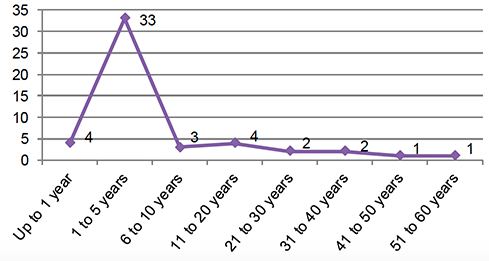
171. Twelve of the 50 cases (24%) were consolidated (often referred to as 'rolling up') with one or more other cases.[47] This can add to the complexity of the cases.
172. Thirty (60%) cases were reported with the accused in police custody. Twelve (24%) were reported by means of an undertaking where the offender had been given a date by Police Scotland to attend court, four (8%) were received as reported cases[48] and the final four (8%) were reported by police seeking a warrant to apprehend the accused.
173. Of the 12 cases reported as undertakings, only three went ahead on the date set with the accused appearing on petition and being committed for further examination. In the other nine cases, the date to attend court was either postponed, cancelled or postponed then cancelled, mainly for further enquiries to be carried out. These nine cases resulted in a variety of outcomes including no action, the accused being placed on petition or, in one instance, the case being referred to the Children's Reporter.
174. Chart 4 shows the outcome of all the cases in our review as at 20 March 2020. Of the 15 cases in which no further proceedings were recommended, this decision was taken after further enquiries had been carried out in six cases; after pre-petition investigation in five cases; after the accused had appeared on petition but before the indictment was served in two cases; and after the indictment was served in two cases. Of the 13 trials that have been completed, the sentencing hearing was outstanding in two. In one case an initial decision on how to proceed had not yet been made (see paragraph 178 for further information about this case).
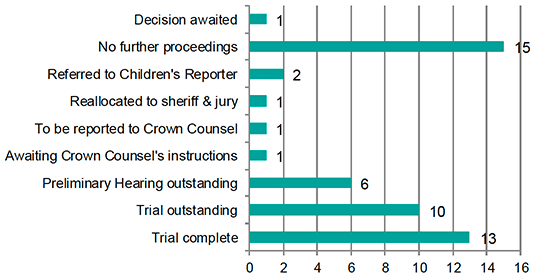
Initial decision-making
175. On receipt of a police report alleging sexual crime, prosecutors make an initial assessment as to what action should be taken. Five (10%) of the 50 cases were appropriately reported to Crown Counsel to seek instruction before the initial assessment was made.
176. In 2017, we reported that one of four assessments could be made:
- to prosecute, usually on petition
- to instruct further investigation prior to deciding whether to prosecute – known as pre-petition investigation
- to take no proceedings
- to use an alternative disposal, such as referral to the Children's Reporter.
177. In our 2020 case review, we noted an additional assessment outcome was often being used, that of 'further enquiries'.[49] In these cases, the results of further enquiries are needed before a decision can be taken. Further enquiries usually take the form of requesting full statements from the police, or requiring a forensic or cybercrime report. Cases assessed as requiring further enquiries differ from those that require pre-petition investigation in that further enquiries relate to further routine investigation. Pre-petition investigation is used to establish by detailed investigation whether sufficient evidence exists, and to address any grave or substantial concerns regarding the quality of evidence.
178. Table 3 shows that 27 (54%) of the cases we reviewed were initially marked for petition proceedings; 17 (34%) required further enquiries; and five (10%) required pre-petition investigation either for eight weeks or 26 weeks to carry out some precognition or perform a full assessment of the evidence. In the one case where the initial decision had not yet been taken, the victim was involved in several cases against multiple accused, the circumstances of which were connected. The other cases did not fall within our sample for review. Given the complexity of the cases, COPFS focused on the case that was strongest evidentially which resulted in the case in our sample not being taken forward pending the outcome of this case. This case concluded around the time our review ended, and a decision on the case in our sample was expected shortly.
| Marking forum | Number |
|---|---|
| Petition | 27 |
| Further enquiries | 17 |
| Pre-petition investigation | 5 |
| Decision awaited | 1 |
179. Chart 5 shows the time taken for initial decisions to be made. In 31 cases (62%), initial decisions were taken on the same day the police report was received, 30 of which were custody reports and one of which was an undertaking. The remaining cases were either warrant requests, undertakings or reported cases.
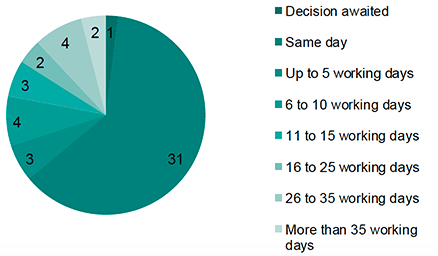
180. In two cases, the initial decision was not made for a considerable period. In both cases, procedural errors resulted in these cases being overlooked and resulted in the initial decisions not being taken until after nine months had passed in one, and more than eight months in the other. These cases are further discussed at paragraph 61.
Further enquiries
181. Where the initial decision is that further enquiries are required, the prosecutor allocates the case one of three KPIs. The KPIs were introduced in March 2018 as a means of managing routine further investigation. The KPIs for further enquiries are:
- four weeks for standard cases (such as requiring full statements or other straightforward clarifying information from the police)
- 12 weeks where a forensic report is required
- 16 weeks where a cybercrime report is required.
182. Chart 6 shows the KPIs applied to the 17 cases in our sample where further enquiries were needed.
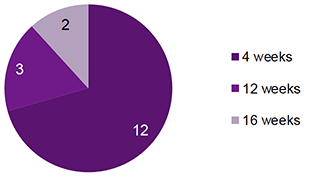
183. In the two cases requiring cybercrime reports, the 16-week KPI was met, and there were only slight delays in the three cases subject to the 12-week KPI for forensic reports.
184. Twelve of the 17 further enquiries cases were subject to the four-week KPI and required full statements to be submitted by the police so as to allow the prosecutor to make a more informed assessment of the most appropriate course of action to take in the case. The four-week KPI was met in only four of the 12 cases. Where the KPI was not met, this was for a variety of reasons, including delays by COPFS in requesting the information, and delays by the police in providing it. In one case in which the four-week KPI was not met, the initial decision was not made for 23 weeks. However, this was due to the complexity of the circumstances, with difficulties experienced in tracing files from 2005 and the need to investigate a potential additional complainer.
185. Overall, for the 12 cases that had a four-week KPI, the time taken for the further enquiries to take place and for a subsequent decision to be taken ranged from three to 23 weeks,[50] with an average of nine weeks.
186. The KPIs for further enquiries run from the date COPFS receives the police report. However, as seen at Chart 5 above, it may be some time before the initial decision to instruct further enquiries is made. This was the case, for example, in one of our cases with a four-week KPI, where the four weeks had already expired before the decision to instruct further enquiries had even been made.
187. Operational Instruction 3 of 2018 states that Crown Counsel's instructions should only be sought at the investigation and initial decision making stage under certain circumstances:
- where the issue of sufficiency of evidence is borderline but not clear
- there appears to be sufficiency of evidence but the quality of evidence requires reflection on whether prosecution is in the public interest (including cases where there appears to be a sufficiency but the complainer would prefer the case not to proceed)
- the case is highly sensitive and/or consideration of complex areas of law is required
- the case marking instructions or other policy guidance for the charge indicate that it must be reported for Crown Counsel's instructions.
188. Four of the 17 further enquiries cases in our review were reported for Crown Counsel's instructions. All were in accordance with the Operational Instruction and resulted in instructions that two of the cases proceed by pre-petition investigation, and in two cases, that the accused should be placed on petition.
189. The outcome for all 17 cases where further enquiries were made is shown in Chart 7.
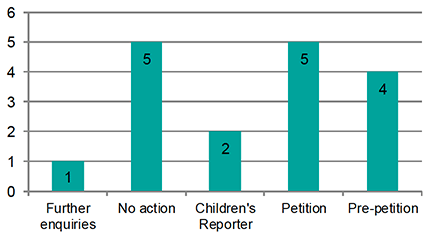
190. In one case, an additional period of further enquiries was instructed. Initially, only full statements were requested with a four-week KPI, but a decision was later taken to request a forensic report with a 12-week KPI. On receipt of a negative forensic result, a decision was made to take no action.
191. In five cases, no action was taken after the initial requests for information. This was a result of there being insufficient evidence after receiving responses to the enquiries.
Pre-petition investigation
192. Operational Instruction 3 of 2018 states that pre-petition investigation can be used to establish by detailed investigation whether sufficient evidence exists, or to address any grave or substantial concerns regarding the quality of evidence. Further investigation that is routine, should be dealt with by the 'further enquiries' process described above, and the Operational Instruction notes that cases where pre-petition investigation is appropriate should be rare.
193. Nine cases in our review were progressed by pre-petition investigation – five following the initial decision and four where further enquiries had already been carried out. While 18% of cases being progressed by pre-petition investigation cannot be described as 'rare', the reasons given in each appeared in accordance with the Operational Instruction.
194. In March 2018, COPFS set refreshed KPIs for pre-petition investigation in Operational Instruction 3 of 2018. The KPIs are that the pre-petition investigation period should be:
- eight weeks where some level of precognition is involved
- 26 weeks where, on a full assessment of the evidence, a full review of the case is required before a decision can be taken in the public interest. In such cases, it is expected that a full review of all the evidence will be carried out and a recommendation sought from Crown Counsel as to whether the case should be indicted.
195. In one of the nine pre-petition cases in our review, a 15-week KPI was set rather than a KPI of eight or 26 weeks. We could find no electronic record of the reason why a different KPI had been set. It was not met, with the pre-petition investigation period exceeding the KPI by six weeks.
196. In the other eight pre-petition cases:
- in three cases, the eight-week KPI was applied but was never met
- in five cases, the 26-week KPI was applied and was met in two cases (at eight and 21 weeks).
197. In the three cases with an eight-week KPI, the period of pre-petition investigation was 11, 17 and 36 weeks. All three cases had already had a period of further enquiries, prior to pre-petition investigation.
198. In the three cases with a 26-week KPI which was not met, the pre-petition investigation period was concluded after 37 and 53 weeks in two cases. In both, the case was reallocated to a different case preparer during the period of investigation and this may have played a role in the delay (or alternatively, the case was reallocated because of the delay). Neither of these cases were subject to further enquiries prior to the pre-petition investigation. In the third case where the 26-week KPI was not met, the pre-petition investigation had still not concluded at the time of our review.
199. In this case, there had already been a 12-week period of further enquiries and, once allocated for pre-petition investigation, almost 11 weeks passed before an initial instruction was sent to the police. The police responded one week later. Almost 11 weeks passed again before a further instruction was sent to the police. During this time, the original 26-week KPI expired and the case was reallocated to a different case preparer. Upon reallocation, the case was given a further eight-week KPI. After further instructions to and responses from the police, the case was reported to Crown Counsel in its 48th week with a recommendation that no proceedings take place due to evidential difficulties and the disengagement of the victim. Four weeks later, Crown Counsel issued further instructions and a further three weeks later, the case was re-reported to Crown Counsel with the same recommendation. The delays and periods of inactivity in this case are unacceptable. Failure to adhere to the KPIs should have resulted in this case coming to the attention of senior managers and action should have been taken as a result to ensure its progress was expedited.
200. Overall, the pre-petition investigation period of the eight cases in our review where the investigation period had concluded ranged from eight to 53 weeks since the case was reported to COPFS. In the ninth case with a period of pre-petition investigation, the investigation had not yet concluded (with 57 weeks having passed at the point our case review ended).
201. Our findings show that there is still a relatively long time in some cases in the investigation stage before a final decision is taken on how to proceed. While this may often be necessary due to the complexity of serious sexual crime cases and the gathering of evidence, the cases outlined above highlight scope to reduce journey times further, supported by improved governance.
202. The outcome of the cases in our review which had a period of pre-petition investigation are shown in Chart 8. As noted at paragraph 200, the outcome of one case is still to be determined although a recommendation of no proceedings has been made.

203. In four of the five cases where no action was taken, evidential issues, particularly insufficiency of evidence, was a factor. In two of these cases, the victim was also reluctant to proceed. In the fifth case, action was not thought to be in the public interest.
Petition
204. Thirty-five (70%) of the cases we reviewed were placed on petition, thereby initiating solemn proceedings. Twenty-seven were placed on petition at the initial decision-making stage, five after further enquiries, two after pre-petition investigation, and one was subject to both further enquiries and pre-petition investigation before being placed on petition. Nineteen of the 35 post-petition cases were still live at 20 March 2020 and 16 were closed.
205. Of the 35 cases in our review placed on petition, the main charge was rape in 27 cases. This included offences contrary to sections 1 and 18 of the 2009 Act and common law offences that were committed prior to the Act, the circumstances of which would now be equivalent to rape.
Indicting decision
206. Of the 35 cases that were placed on petition, 34 were reported to Crown Counsel with a recommendation on how to proceed. One case had still to be reported at the time of our review following a delay of approximately nine months in making an initial decision.[51] In the 34 cases reported to Crown Counsel, we found that Crown Counsel agreed with a high proportion of the recommendations made:
- in 30 cases, Crown Counsel agreed with the recommendation to commence proceedings in the High Court
- in one case, Crown Counsel agreed that there should be no further proceedings
- in one case, Crown Counsel instructed prosecution at Sheriff and Jury level rather than in the High Court as recommended
- in one case, Crown Counsel disagreed with the recommendation to commence proceedings and instructed no proceedings
- in one case, we were not able to find an electronic record of the recommendation made by the case preparer and SLM so could not assess whether Crown Counsel agreed with it. However, the decision of Crown Counsel in this case was to indict.
207. In the two cases where Crown Counsel decided no further proceedings should be taken, there was insufficient evidence in one and, in the other, there were evidential difficulties and the victim had disengaged from the process.
208. The case where prosecution at Sheriff and Jury level was instructed involved a very young child victim. Work that was identified at an early stage was not done until 10 months after the police report had first been looked at. This delay, particularly in a case involving a very young child victim, is not acceptable.
Reporting and indicting KPIs
209. In response to our review of sexual crime published in 2017, COPFS introduced new KPIs for the reporting and indicting of post-petition High Court cases. These KPIs were designed to support efforts to shorten the journey time of cases. Each case is assigned a priority based on its circumstances and placed into one of four categories (see Table 4), taking into account factors such as whether the accused is in custody, the age of any child witnesses and the accused, and the time the case has already spent in the pre-petition phase, as well as any other priority factors.
| Category | Report by[52] | Indict by |
|---|---|---|
| 1 | 60 days | 70 days |
| 2 | 6 months | 7 months |
| 3 | 7 months | 8 months |
| 4 | 8 months | 9 months |
210. The new reporting and indicting KPIs were effective from 1 April 2019, however some were in use as early as October 2018 (in relation to cases involving child witnesses aged 12 years and under which fall into Category 1) and 1 January 2019 (in relation to all other cases falling into Category 1, such as those where the accused is remanded in custody). In bail cases, the KPIs are intended to run from the date of receipt of the police report while in custody cases, the KPIs run from the date where the accused person is fully committed.
211. The cases that we reviewed were reported to COPFS between 1 September 2018 and 28 February 2019. All cases were reported before the new KPI regime was fully implemented on 1 April 2019, although some cases were subject to the KPIs that were brought in early. We acknowledge that the new KPI regime was not fully in place at the time all of the cases in our sample were reported and that compliance was not then being routinely monitored. Nonetheless, we have considered 12 cases in our sample where records show that the case had been allocated to a priority category and the reporting and indicting KPIs had been applied. From these cases, we have identified some issues for COPFS to consider as it continues to develop and apply its approach to KPIs. The indicting KPIs are discussed above from paragraph 32.
Bail cases
212. Of the 35 petition cases, the accused was on bail in 24 cases. Eight of the bail cases had involved a period of further investigation – five with further enquiries, two with pre-petition investigation and one with both. We found evidence in the case records that both the new reporting and indicting KPIs had been applied by COPFS to seven of the 24 bail cases:
- in one case, both reporting and indicting KPIs were met
- in three cases, neither the reporting nor the indicting KPI had been met
- in three cases, the reporting KPI was met but not the indicting KPI.
213. In a further case, the reporting KPI was met but the indicting KPI was not relevant. This was because Crown Counsel instructed that the accused should be indicted into the Sheriff Court[53] and therefore it was not further considered in our review, given our focus on High Court sexual crime cases.
214. There was evidence in some, but not all, cases that delays at the initial decision-making or pre-petition stage were being taken into account when allocating cases to a priority category. This means that, if the KPIs are used effectively, there is scope for cases that have experienced previous delays to be expedited post-petition, which we welcome. However, in two cases which had been re-prioritised to take account of previous delays, the opportunity to make up for those delays had subsequently been missed and the new KPI had been exceeded by a significant margin.
215. There appeared to be some inconsistency in the dates used to commence the KPI timescale. While guidance states that this should be the date of the police report for bail cases (except in specified circumstances), in two of the seven bail cases to which a reporting and indicting KPI had been applied in our review, the KPI instead ran from the date of the accused's first appearance at court. In one of these cases, there was an almost nine-month gap between the police report and first appearance. Inconsistency in the application of the KPIs to cases limits their utility and the ability of senior managers to identify at what stage problems are occurring and take action to address them.
216. In some bail cases where the further enquiries or pre-petition investigation has been protracted, it is impossible or near impossible for the reporting and indicting KPIs to be met.
217. In most bail cases, a considerable period of time passed between the case being reported to Crown Counsel and their instructions being made, and the indictment being served:
- in two bail cases prioritised as Category 1 due to the involvement of child victims under the age of 12, the indictments were served three and six months after the case was reported to Crown Counsel. The target was 10 days. This was despite Crown Counsel's instructions to indict the accused being received promptly. In one of these cases, considerable efforts to meet the reporting KPI were somewhat negated by the delays at the indicting stage.
- in several bail cases falling outwith Category 1 where the aim was to serve the indictment within one month of reporting to Crown Counsel, the indictment was served between three months and almost five months later, despite instructions from Crown Counsel to indict the accused being issued promptly.
218. While the indicting KPIs were missed in these cases, in all of them the indictment was served within the statutory time limit (which, in bail cases, is taken from the date of the accused's first appearance on petition when they are committed for further examination, rather than the date of the police report).
Case studies – reporting and indicting KPIs
In our review, both the new reporting and indicting KPIs were met in only one of the nine bail cases to which they were applied. This case fell within Category 4 and was reported to Crown Counsel over two weeks prior to the target date. The indictment was served three days prior to the target date.
One of the bail cases in which neither the reporting nor the indicting KPI was met was prioritised as Category 1 due to the involvement of child witnesses under the age of 12. The case was reported to Crown Counsel on day 106 (target 60 days) and the indictment was served on day 259 (target 70 days).
219. Of the 16 bail cases where the new reporting and indicting KPIs had not been applied, COPFS staff had applied target reporting dates from the date the accused was committed for further examination. The reporting date set was met in seven of the 16 cases. The reporting date set was not met in nine cases, with the additional time taken to report ranging from one to 15 weeks. In all 16 cases, the indictment was served within the statutory time limit of 10 months. In one of the cases which did not meet the target report date, the indictment was nonetheless served seven weeks prior to the statutory time limit. This case involved a child accused with child victims and witnesses, suggesting that efforts were made to prioritise some cases involving children even before the new reporting and indicting KPIs were introduced.
Custody cases
220. There were 11 post-petition cases where the accused was remanded in custody. None had a period of further enquiries or pre-petition investigation before being placed on petition. The new reporting and indicting KPIs were relevant to five of the 11 cases. This was because four of the cases were reported after 1 January 2019, and the fifth case was reported in October 2018 but related to a child victim under the age of 12. All five cases were assessed as being Category 1, meaning that they should be reported to Crown Counsel within 60 days of the accused having been fully committed, and the indictment served within 70 days of that date.
221. The reporting KPI was not met in three of the five cases and the indicting KPI was not met in any cases. However, the indictment was served in all cases within 80 days of the accused being fully committed, thus meeting the statutory time limit. In the two cases where the reporting timescale of 60 days was met, the indictment was served on the last possible day in one case, and two days before this in the second case.
222. Of the six post-petition custody cases where the KPIs did not apply, only one case was reported to Crown Counsel before the target date. However, the indictment was served within the statutory time limit in all cases.
223. In summary, all cases are being indicted in accordance with statutory time limits, and we welcome efforts to use the new performance framework to shorten the journey time of cases by identifying the stages at which delays are occurring so that corrective action may be taken. This affords opportunities to minimise delays and improve the experience of victims, witnesses and the accused. The framework was not fully operational at the time the cases in our sample were first reported to COPFS, and we have highlighted some issues above which will require to be resolved to maximise the benefit to be gained from it. We acknowledge that the framework's implementation and development since April 2019 may have resulted in more positive outcomes for cases reported after that date. The framework should be kept under review and refined as necessary, to ensure it serves its purpose and takes account of the complex circumstances of individual cases. Most importantly, corrective action must be taken to address issues highlighted by missed KPIs. This could include, for example, redistribution of resources to address delays at key points in the investigation and prosecution process. For further discussion of the KPIs, see from paragraph 32.
Section 67 notices[54]
224. In our 2017 review of sexual crime, 88% of the cases we reviewed had additional productions, labels or witnesses added after the indictment had been served. These are added by means of a written notice, known as a section 67 notice, which may be objected to by the defence and/or refused by a judge. We noted that while requests for further work at this stage are unlikely to ever be eliminated due to factors outwith the control of COPFS, there is scope for this work to be reduced. We also noted the risk that courts may not allow section 67 notices which would endanger the ability of COPFS to effectively prosecute the case.
225. In our current case review, we noted section 67 notices were made in 25 (71%) of the 35 cases that progressed to petition proceedings. Thirteen cases required more than one section 67 notice (see Chart 9). A large volume of work is therefore still necessary after the indictment stage. This may also provide an insight into the complexity of serious sexual crime cases where the results of forensic or cybercrime analysis or expert reports may be received during the latter stages of the investigation and prosecution process.

Preliminary hearings[55] and trial
226. Statutory time limits regulate the maximum length of time that can elapse between the first time a person appears in court on petition charged with an offence and the start of their trial on indictment on that charge.[56] Different time limits apply depending on whether an accused person is remanded in custody or on bail:
- if the accused is committed for further examination and released on bail, the prosecution must serve an indictment no later than 10 months from that date, the preliminary hearing must take place within 11 months and trial must be commenced within 12 months[57]
- if the accused person is fully committed and remanded in custody, the prosecution must serve an indictment within 80 days, the preliminary hearing must take place within 110 days and trial must be commenced within 140 days.[58]
227. Extensions to time limits can be granted if there is sufficient cause to justify an extension. In any proceedings where a diet has been fixed on indictment, the court may, if it considers it appropriate to do so, adjourn the diet under section 75A of the 1995 Act.[59] An application for continuation or adjournment to another date may take place in court at the request of the prosecution or defence, or jointly by both parties. Where both the prosecution and defence are in agreement that a new date (referred to as a diet) should be fixed, the court may discharge the previous diet and fix a new diet without a hearing taking place in court.[60]
Bail cases
228. Of the 21 bail cases where petition proceedings had been commenced, one was still to be reported to Crown Counsel at the time we completed our review. Of the remaining 20 bail cases, there was a preliminary hearing held within the 11-month statutory time limit in 14 cases, 10 of which resulted in a trial diet being fixed and four of which resulted in the preliminary hearing being continued to another date.[61] In the remaining six bail cases, applications under section 75A of the 1995 Act to discharge the initial preliminary hearing that had been fixed were granted by the court and further dates were fixed for the preliminary hearings to take place and relevant statutory time limits extended accordingly.[62]
229. In total, one or more applications under section 75A were made to delay or continue the preliminary hearing to another date in seven of the 20 bail cases. These applications were made for a variety of reasons, and at the instance of both the prosecution and the defence, or both. For example, in one case, the preliminary hearing was continued to allow the prosecution to interview the victim in relation to a section 275 application by the defence.[63] In another case, the accused failed to attend a preliminary hearing and a warrant was obtained for his arrest. The case was re-indicted with a new preliminary hearing date. Further preliminary hearings in the case were continued or delayed for a number of reasons, including matters associated with vulnerable witness applications and transcripts.
230. In all 20 bail cases, the statutory trial time limit of 12 months for a trial to be commenced had to be extended, even prior to the Covid-19 pandemic.[64] In four of the 20 cases, the trial diet was still to be fixed as at March 2020 and in one case a decision was taken to proceed no further as the elderly accused was already serving a 21-year sentence. Of the 15 cases where trial dates had been set, we found the time between the first preliminary hearing and the trial ranged from 12 to 41 weeks. In six of these 15 cases, delays to or continuations of the preliminary hearing resulted in a delay to the trial being fixed. However, even in the nine cases where there was no delay or continuation of the preliminary hearing, we found that the time between the preliminary hearing and the trial ranged from 12 to 25 weeks.
231. Of the 15 cases where trials had been set, four had been concluded while 11 were still live. Of the four concluded cases, the time taken for the cases to reach trial from both the date that they were reported to COPFS and the date the accused was committed for further examination are shown at Table 5. This illustrates the point that none of the trials took place within the statutory time limit of 12 months, and one trial took almost 17 months to commence.
| Case number | Police report to trial (weeks) | CFE to trial (weeks) |
|---|---|---|
| 6 | 69 | 69 |
| 21 | 74 | 74 |
| 28 | 59 | 59 |
| 33 | 67 | 61 |
232. Of the 15 cases where trials had been set, the trial had not yet taken place in 11. The time taken for these cases to be scheduled for trial are shown at Table 6. However, in all these cases, the trial was postponed due to the Covid-19 pandemic. Further analysis of the impact of the Covid-19 pandemic can be found in Part 3 of this report. The table shows that none of the trials would have taken place within the usual statutory time limit of 12 months. The shortest delay would have occurred eight weeks after the statutory time limit if the trial had gone ahead as scheduled, while in the case with the longest delay, the trial would have taken place 36 weeks (eight months) after the usual statutory time limit.
| Case number | Police report to trial (weeks) | CFE to trial (weeks) |
|---|---|---|
| 7 | 68 | 68 |
| 8 | 60 | 60 |
| 10 | 80 | 80 |
| 11 | 85 | 73 |
| 14 | 74 | 69 |
| 17 | 70 | 70 |
| 19 | 68 | 68 |
| 31 | 94 | 88 |
| 40 | 75 | 61 |
| 42 | 70 | 70 |
| 50 | 75 | 62 |
Custody cases
233. Of the 11 cases where the accused had been remanded in custody, the preliminary hearing took place within the initial statutory time limit of 110 days from the accused being fully committed in six cases. In five cases, one or more applications under section 75A of the 1995 Act were made to delay or continue the preliminary hearing to a later date. In one of these cases, four section 75A applications were made and granted without a hearing taking place, resulting in the first preliminary hearing in court taking place five months after the first that had originally been fixed. In these five cases, the section 75A applications were made for a variety of reasons and at the instance of both the prosecution and defence, or both. For example, in one case, a new diet was sought because the accused had instructed a new solicitor. In another case in which there had been a section 75A application to delay the initial preliminary hearing, when the case was called for preliminary hearing, there was a further continuation to a later diet. In this case, there were 21 complainers and substantial documentary productions and telephony evidence, illustrating the complexity of some serious sexual crime cases.
234. In two of the 11 cases where the accused was remanded in custody, the accused pled guilty at the first preliminary hearing so there was no need to fix a trial. In one case, the accused was released on bail, thereby altering the statutory time limits. In the other eight cases, the statutory time limit of 140 days for the trial to be commenced was extended, sometimes following continued preliminary hearings. However, the time limit for the trial diet to commence was also extended in cases where there had been no delays at the preliminary hearing stage. In one of these eight cases, the statutory time limit of 110 days for the preliminary hearing to be held had been extended twice and the accused pled guilty at the second preliminary hearing.
235. In the remaining seven custody cases where the accused had not already pled guilty or been released on bail, we found that the time between the first preliminary hearing and the trial ranged from 13 to 40 weeks.
| Case number | First PH to trial (weeks) |
|---|---|
| 5 | 23 |
| 16 | 19 |
| 22 | 34 |
| 29 | 13 |
| 34 | 14 |
| 35 | 40 |
| 41 | 37 |
236. While the trial should commence within 30 days of the preliminary hearing, the time between the final preliminary hearing and the trial was more than this in all seven cases:
- in two cases, the trial was set three months after the first and only preliminary hearing
- in one case, the trial was set four months after the first and only preliminary hearing
- in two cases, the trial was set two months after the final preliminary hearing
- in one case, the trial was set three months after the final preliminary hearing
- in one case, the trial was set five months after the final preliminary hearing.
237. Of the seven custody cases that proceeded to trial, four are concluded and in two the accused has been found guilty but sentencing is outstanding. The time taken for a trial to be commenced in the four cases from both the date that they were reported to COPFS and the date the accused was fully committed are shown at Table 8. None of the trials took place within the statutory time limit of 140 days (20 weeks) from full committal. The longest period of time that passed between full committal and trial was 53 weeks.
| Case number | Police report to trial (weeks) | FC to trial (weeks) |
|---|---|---|
| 5 | 40 | 38 |
| 16 | 35 | 34 |
| 29 | 30 | 29 |
| 34 | 31 | 29 |
| 35 | 70 | 53 |
| 41 | 54 | 53 |
238. Of the seven custody cases where trials had been set, the trial had not yet taken place in one case. It was scheduled for 49 weeks after the date the accused was full committed. The trial was ultimately postponed due to the Covid-19 pandemic.
239. The delay in cases reaching trial is a concern and is discussed further at paragraph 63.
Contact
Email: carolyn.sharp@gov.scot
There is a problem
Thanks for your feedback